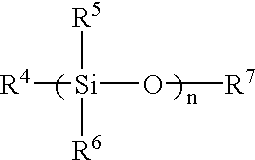Silyl (METH) acrylate copolymers, processes for preparing the same, antifouling paint compositions containing the silyl (METH) acrylate copolymers, antifouling coating films formed from the antifouling paint compositions, antifouling methods using the antifouling paint compositions, and hulls or underwater structures coated with the antifouling coating films
a technology of acrylate copolymer and acrylate, which is applied in the field of silyl (meth) acrylate copolymer, can solve the problems of increasing the roughness of the whole ship, affecting the antifouling performance of the ship, and requiring a long time of work, so as to achieve excellent antifouling performance, excellent adhesive strength, and favorable control of the hydrolysis rate
- Summary
- Abstract
- Description
- Claims
- Application Information
AI Technical Summary
Benefits of technology
Problems solved by technology
Method used
Image
Examples
polymer preparation example preparation
of Silyl (Meth)acrylate Copolymer (A-1)
A reactor equipped with a stirrer, a condenser, a thermometer, a dropping device, a nitrogen feed pipe and a heating / cooling jacket was charged with 100 parts of xylene, and the xylene was stirred under heating at a temperature of 85.degree. C. in a stream of nitrogen. With maintaining the same temperature, a mixture of 50 parts of triisopropylsilyl acrylate, 45 parts of methyl methacrylate, 5 parts of 2-hydroxypropyl acrylate and 1 part of 2,2'-azobisisobutyronitrile (polymerization initiator) was dropwise added to the reactor over a period of 2 hours by means of the dropping device. After the reaction solution was stirred for 4 hours at the same temperature, 0.4 part of 2,2'-azobisisobutyronitrile was added, and the mixture was further stirred for 4 hours at the same temperature to obtain a colorless transparent solution of a silyl (meth)acrylate copolymer (A1-1).
The thus obtained solution of the copolymer (A1-1) had a heating residue (after ...
examples p1 to p29 , examples 01 to 052
Examples P1 to P29, Examples 01 to 052, Comparative Examples PO1 to PO5, Examples R1 to R23, and Comparative Examples R1 to R5 to Prepare Antifouling Paints Examples to Prepare Antifouling Paint Compositions
To prepare antifouling paint compositions having formulations shown in Tables 8 to 11 (Examples P1 to P29), Tables 12 to 18 (Examples Q1 to Q52, Comparative Examples PQ1 to PQ5) and Tables 19 to 21 (Examples R1 to R.sup.23, Comparative Examples R1 to R5), the ingredients were shaken all together for 2 hours in a paint shaker containing glass beads and then filtered through a 100-mesh filter. Thus, the desired antifouling paint compositions were obtained.
The antifouling paint compositions were stored for 2 months at ordinary temperature to evaluate storage stability. The results are set forth in Tables 8 to 21.
In the evaluation of storage stability, a viscosity (Ku value measured at 25.degree. C. by a Stormer's viscometer) of each antifouling paint composition was measured immedia...
PUM
| Property | Measurement | Unit |
|---|---|---|
| Percent by mass | aaaaa | aaaaa |
| Percent by mass | aaaaa | aaaaa |
| Percent by mass | aaaaa | aaaaa |
Abstract
Description
Claims
Application Information
 Login to View More
Login to View More - R&D
- Intellectual Property
- Life Sciences
- Materials
- Tech Scout
- Unparalleled Data Quality
- Higher Quality Content
- 60% Fewer Hallucinations
Browse by: Latest US Patents, China's latest patents, Technical Efficacy Thesaurus, Application Domain, Technology Topic, Popular Technical Reports.
© 2025 PatSnap. All rights reserved.Legal|Privacy policy|Modern Slavery Act Transparency Statement|Sitemap|About US| Contact US: help@patsnap.com



